
Link to: University of Ghana, Faculty of Arts, Music Department
AFRICAN POPULAR MUSIC
(a historical review of sub-Saharan Africa)
by Professor John Collins (March 2002)
INTRODUCTION
This article deals with the transcultural popular music styles of sub-Saharan Africa that has evolved since the 19th century as a blend of local elements and imported ones from the West, Islam and the black diaspora of the Americas. The latter has acted as a catalyst in the creation of many African popular music genres even in colonial times and can be treated as a black musical ‘homecoming’ (A. A. Mensah, 1971), ‘cultural feedback’ (Stearns, 1988), ‘affinity’ (Roberts, 1974) or ‘resonance’ (Jacobs, 1989).
As the outside influences were initially introduced via European ports there is often a pattern of coastal musical styles diffusing inland and subsequently becoming more regionalised or indigenised. Moreover, the fact that African popular music not only partly draws on tradition but continually interacts with a living folk culture has created neo-traditional genres that break down the usual folk/pop polarity model of western music.
African popular music arose within the colonial context and so the emergence of distinct African genres is partly the story of musical de-colonisation. Popular music also mainly evolved in the modern urban centres and so in some cases has provided a trans-ethnic, national and even Pan African lingua franca.
Its practitioners are drawn largely from the intermediate layers of African society who neither belong to the peasantry nor the elite. They therefore act as a cultural bridge or nexus for the modern and traditional, imported and indigenous. African popular musicians are also role models for the young and their emergent music (and dance) styles often reflect youth cultures in opposition to established mores. Indeed, in many ways African popular music can be seen as an modern extension of traditional recreational music that is customarily associated with youthful age-sets and supplies an arena for generational identity and conflict.
Many popular artists became actively involved in the nationalist struggle. After independence the indigenisation of the arts was encouraged by the new African governments, augmented by black diasporic Afro-centric ideas found, for example in soul and reggae music. Since independence increasingly larger numbers of women have professionally entered the African popular music business,
EUROPEAN MILITARY BANDS
The earliest European musical impact on Africa came through regimental bands (fife-and-drum and later brass bands). At first, for obvious military reasons, there was a reluctance to teach Africans European martial marching music. An exception was the formation of the Akrampo Number Six Asafo (warrior) Company in 1655 at Cape Coast, Ghana, composed of mulatto soldiers (de Graft Johnson,1932). However, by the mid-19th century local brass bands had appeared as far apart as the ‘native band’ of Cape Coast Castle in Ghana (Beecham 1841) and the cape-coloured one of Cape Town, South Africa (Coplan 1965)
| Krobo Brass Band around 1900 (courtesy of Basel Mission Archives) |
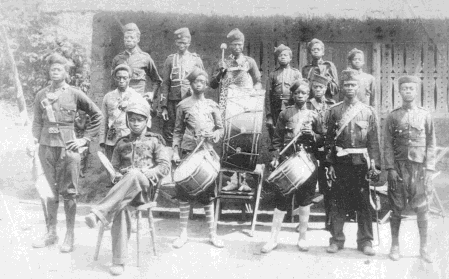 |
In West Africa West Indian troops were stationed by the British in Freetown (1819), Cape Coast (1870) and late 19th century Lagos. In Ghana these Caribbean soldiers, numbering about six thousand, helped catalyse the formation of local Fanti ‘adaha’ brass band music that used indigenous and Caribbean rhythms. These bands spread through southern Ghana during the cocoa boom of the early 20th century, and a poor-man’s ‘konkoma’ or ‘konkomba’ version (using percussion and voices only) appeared in Fanti-land in the 1930s. Konkoma spread as far east as Nigeria and helped establish a neo-traditional variant in the Ghana/Togo area known as ‘borborbor’. Waterman (1990) mentions that the West Indian troops in Lagos were one of the formative influences on local Nigerian brass band music of the 1920’s.
In East Africa brass band music or ‘beni’ was associated with late 19th century coastal Kenyan uniformed parades and later the ‘askaris’(local soldiers) of German Tanganyika (Ranger 1975). After the first World War beni music moved inland and (paralleling konkoma) became indigenized. Western instruments were dropped, the local gourd kazoo became important and the music became polyrhythmic. Beni also became a focus for youthful conflict with village elders and an organising factor in the 1935 Copperbelt strike. Although initially coastal beni was trans-ethnic, its later local offshoots were more ‘tribal’ and included the mbeni of the Bemba people (Jones 1945) and the kalela of Bisa mine-workers (Mitchell, 1956).
FREED SLAVES
The music of freed African slaves was another seminal influence on African popular music and the first case is Jamaican goombay, a frame-drum music associated with the neo-African myelism healing-cult (Bilby, 1985). Goombay was taken to Freetown, Sierra Leone in 1800 by Jamaican maroon rebels freed by the British. From 1900 goombay spread to many other West African countries including Mali (gube), the Cote d'Ivoire (le goumbe), Ghana (gome), Senegal, Burkina Faso, Nigeria, Fernando Po and the Cameroons.
Accra, Gome Group
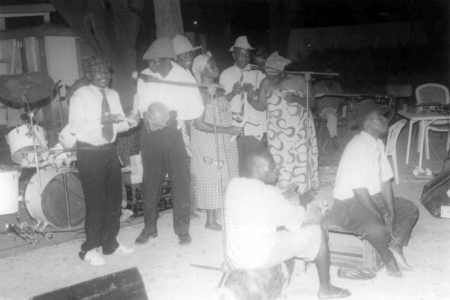
Asiko (or Ashiko) is an early Pan West African popular music played on frame-drums and musical saw (later guitar and accordion) that was created in the late 19th century by the descendents of Yoruba slaves (Aku's) liberated in Freetown by the British after their 1807 ban on the slave trade.
The British anti-slaving cruisers also operated off the East African coast from the 1840's and settlements of freed slaves were established in Kenya (like Freretown) by church mission societies. It was from the resulting Christian elite and ‘Bombay Africans’ (sent to India by the British to be educated) that the local ‘dansi’ of the 1920's emerged, modeled on western ballroom dance-music. More indigenous Luo variants played on accordion evolved inland.
SAILORS AND STEVEDORES
As the initial European settlements in sub-Saharan Africa were coastal, ports became an important musical interface. In early 20th century West Africa dockside groups were formed that combined African and imported melodies, rhythms and instruments, including the portable one of seamen: the accordion, harmonica, banjo (originally an African instrument), penny whistle and guitar. The first to do this were the maritime Kru people of Liberia who worked onboard European sailing ships from Napoleonic times. In the early twentieth century they created the distinctive West African two-finger guitar plucking technique and spread their ‘mainline’, ‘dagomba’ and ‘fireman’(i.e. steam-ship’s stoker) styles up and down the West African coast in their 'kru-towns'. Variants known collectively as ‘palmwine’ music or ‘native blues’ appeared in Sierra Leone, Ghana and Nigeria.
| Kru Town in 1898 (from G.E. Brooks) |
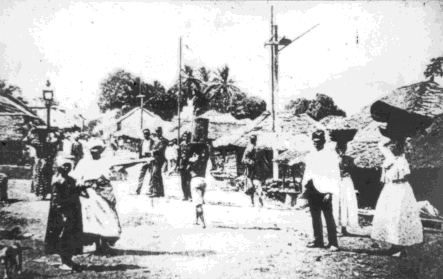 |
In Sierra Leone palmwine music was combined with goombay to create ‘maringa', first recorded by Ebenezer Calender in the 194O's. The coastal palmwine styles of Ghana (osibisaaba, annkadammu and timo) moved inland during the 1920's, evolving into regional styles such as 'odonson' or 'Ashanti blues' that absorbed modulations and melodies from the traditional seprewa harp-lute. It was the Ghanaian Fanti guitarist Kwame Asare (Jacob Sam) and his Kumasi Trio that in 1928 first recorded palmwine music, including the famous Ghsanaians song Yaa Amponsah. They recorded for the Zonophone Company of London , one of the many foreign record companies that tapped into the lucrative pre-war ‘native records’ market of West Africa based on a boom in cash-crops like cocao. Kwame Asare and the many Ghanaian recording artists who followed (Mireku, Kwese Menu, Osei Bonsu, Appiah Adjekum, etc) paved the way for the larger guitar-band of the postwar period.
|
Ebenezer
Calender
|
Kumasi
Trio in 1928
|
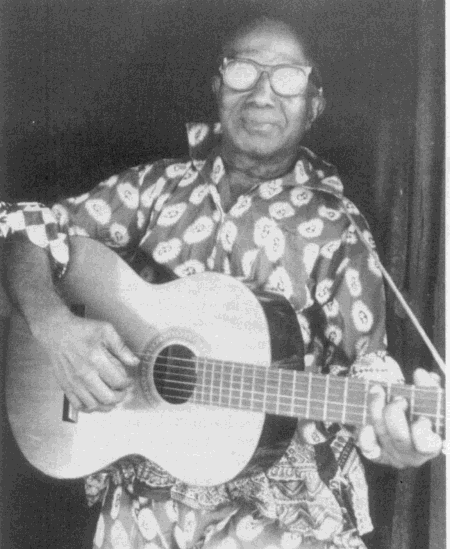 |
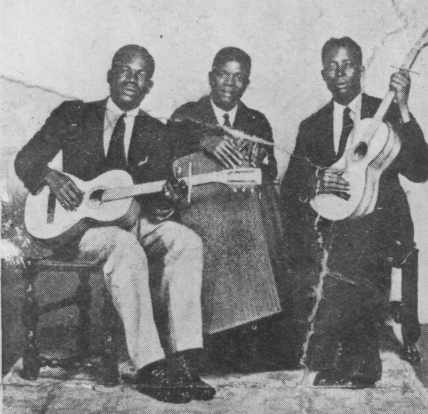 |
By the 1920's Lagos had it's own palmwine and native blues groups (e.g. the Jolly Orchestra). During the early 1930's this was combined with Yoruba praise music and asiko by Tunde King and Ayinde Bakare ‘rascals’ and ‘area boys’ (Alaja-Browne,1985) of the ‘saro’ (Sierra Leonian) quarter of town. The result was called 'juju' music, an onomatopoeic word derived from the sound of the local tambourine, called an ‘asiko’ or ‘samba’ drum. By the mid-1930's juju music had become the popular salon praise-music of the Yoruba elite.
Five thousand West African ‘coastmen’ were recruited by King Leopold for the Congo Free State from the 1880's (Cornet, 1953) as clerks, artisans, sailors, railroad workers and contract workers. It was they who set up the country's first dance orchestra of the Congo River (the Excelsior Orchestra) and taught the two-finger guitar technique to local sailor-musician Dondo Daniels and Antoine Wendo. This two-finger technique reached Swahili speaking eastern Congo in the late 194O's and, combined with rumba influences, was popularised through records by Jean Bosco Mwenda and Losta Abelo. Known as the ‘dry’ (i.e. non-amplified) guitar style it influenced East African guitarists such as Kenya's John Mwale and Malawi's Kachamba Brothers. There, like its West and Central African predecessors, it was associated with drinking bars and held in low esteem. A similar guitar picking style (Zulu ‘utikpa’) became popular in southern Africa during the fifties called ‘jive’ or ‘twist’ played by Ndebele (eg. Zimbabwe's George Sibanda) and Zulu artists(e.g. South Africa's John Bhenga). Whether it was an independent creation or stemmed from the ‘dry’ style is a matter of debate.
The Congolese ‘coastmen’ and mine-workers helped spread the Congo Kinshasha's earliest recognised local popular music style, ‘maringa’ (Kazadi, 1973). It evolved around 1914 in the coastal Matadi-Kinshasha area and spread as far as the Shaba mining camps by the 1920's. It was played on frame-drums and likembe hand-piano (later accordion and guitar) and was sung in the new evolving trans-ethnic Lingala trade language of Central Africa. It was played in bars in informal dancing and was frowned upon by Christians.
THE MISSION EDUCATED AFRICAN ELITE
Mission schools introduced the sol-fa notation and western harmony to Africans, and during the 19th century the educated local elite sang European hymns, cantatas and marches and had their ‘dignity ball’ of Freetown (Harrev, 1987, Handel Festivals and ‘grand theatre’ of Lagos (Echerno, 1962) and ‘rainbow balls’ of South Africa (Coplan, 1985). However, after the development of producing the anti-malarial quinine drug in large commercial quantities and the 1884 Berlin Conference, the ‘scramble for Africa’ began in earnest. In English-speaking Africa the ‘índirect’ system of colonial rule through local chiefs and emirs was instituted and the educated black elites, middlemen and coastal merchant princes were denied institutional power. As a result the educated local elites turned towards modern African nationalist movement and separatist African churches multiplied that played vernacular hymns. An early example is southern African ‘makwaya’ (i.e. choir) that combined European hymnody with African-American spirituals and close close-harmony singing. Enoch Sontonga's famous 1897 nationalist anthem ‘Nkosi Sikelele Africa’ falls into this category. Similar early African choral composers were Ephraim Amu of Ghana and Reverend Ransome-Kuti of Nigeria.
In South Africa during the 1920's makawaya went secular and became associated with the refined Zulu music of pianist Ruben Caluza. Combined with ragtime and the music of diamond and gold miners (Sotho focho/disorder music and Zulu acapella close-harmony ‘nightmusic’) makawaya also became transformed into ’marabi’ associated with working-class shebeen bars and prostitution. The African elite loathed marabi, but endorsed Caluza’s art-music style of makwaya, as well as prestigious ragtime bands of the period (Versatile Seven and Jazz Revel1ers), located in Johannesburg’s black middle-class Queenstown district known as ‘little jazz town’. During the 1930’s the black elite shifted its attention to big-band swing music, supplied by the Merry Blackbirds, Jazz Maniacs and early Manhattan Brothers that played in Johannesburg’s black night-club district of Sophiatown. Similarly neighbouring Zimbabwe had its own jazz artists: Dorothy Mazuka and the Milton Brothers.
As mentioned earlier, the educated coastal Africans of East Africa created ‘dansi’ orchestras that played foxtrots, and ballroom music for high-class dancing clubs. In English-speaking West Africa there was a similar situation as the coastal elites there established numerous symphonic-like dance orchestras. The earliest was the 1914 Excelsior Orchestras of Ghana and by the 1920’s these included the Jazz Kings and Cape Coast Sugar Babies of Ghana, the Lagos City Orchestra of Nigeria and the Dapa Jazz Band and Triumph Orchestra of Freetown. In the case of Ghana, it was during the 1920's, when the prestigious dance groups began to orchestrate local melodies, that the term ‘highlife’ (i.e. high-class) was coined.
|
Cape
Coast Sugar Babies in Nigeria in 1937
|
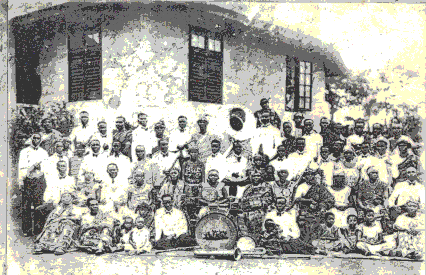 |
VISITING MINSTREL SHOWS, RECORDS AND EARLY FILM
White American blackface minstrel groups first visited Africa (Cape Town) in 1859 but made little impact on the local music scene. However, this changed in the 1890’s when African-American groups such as MacAdoo’s Virginia Jubilee Singers began visiting South Africa (Erlmann, 1988), bringing with them ‘coonsongs’, ragtimes, spirituals and the cakewalk dance. As a result, local African minstrel groups were formed, there were ‘coon carnivals’ by Cape Town’s ‘cape-coloureds’ and ragtime bands like the Darktown Negroes were started.
Ebun Clark (1979) refers to minstrel shows in late 19th century Lagos, whilst Nunley (1987) mentions an African Comedy Group in Freetown in 1915. Minstrel and vaudeville sketches became popular in Ghana around 1903 (personal communication C.M. Cole l996) and in 1918 (Sutherland,1970). Furthermore, between 1924-6 the African-American (or possibly Americo-Liberian) or Glass and Grant team was based in Accra that influenced Williams and Marbel of Accra and Williams and Nikol from Freetown. This local vaudeville or ‘concert party’ of the local elites rapidly became indigenised during the 1930’s by popular theatre groups like Bob Johnson’s and the Axim Trio.
|
Williams
and Marbel in 1923
|
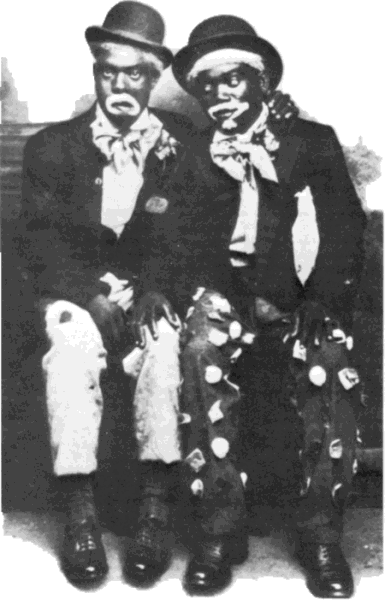 |
From around 1900 records and film became an important source of musical innovation. Early imported records included western classical pieces, popular dances ‘coon songs’, ragtimes, spirituals, singing cowboy songs (e.g. Jimmy Rodgers) and Hindi music (in East Africa). By the late 1920's African vernacular records were being distributed in both East and West Africa and in 1930 the Venezuelan GV label began distributing Afro-Cuban and Latin-American music. Silent, and later talking films introduced comic sketches, dance routines, minstrel acts and ‘jazz shorts’.
ISLAMIC INFLUENCES
Although not as widespread as the popular music arising out of the African contact with European and American culture, Islam has created popular genres on both sides of the continent. Aristocratic Egyptian music (played on Danbuk clay-pot drum, the ud or lute and the kanum zither) was taken to the Zanzibar Emirate in the 1870's where, during the 1920's, it became transformed into local taarab music. This were sung in Swahili (the old Afro-Arab trade language of East Africa) and employing western violins and accordions with indigenous ngoma drums. During the 1930's taraab spread to the Tanzanian mainland and Kenya and later absorbed elements from Indian music.
|
Taarab
group (mid 1960's)
|
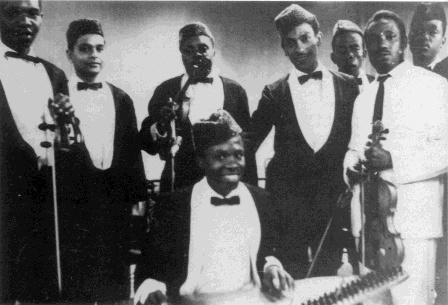 |
Late 19th century ramadan festival-music of western Nigeria (female waka and male were genres) was the basis of sakara Yoruba popular music of the First World War period, played on clay-pot ‘sakara’ drum, molo lute and one-stringed goje fiddle. It was a praise-music associated with the rise of modern Islamic associations. In the 1940's, combined with juju music, sakara led to apala music popularised by Haruna Ishola. During the 1970’s sung elements of were, sakara and apala (Islamic nasalisation, microtones and melisma) were drawn into fuji music that employs sakara and hour-glass drums and an eclectic array of western instruments. The word was coined by Ayinde Barrister and from the 1980’s it replaced juju as the dominent popular music of Yoruba christians and muslims alike.
THE IMPACT OF THE SECOND WORLD WAR
The Second World War not only accelerated the African independence movement but also deeply affected popular music and entertainment. Foreign troops were stationed in many African countries. American and British servicemen brought with them swing-jazz (as well as rumbas and calypsos) and the associated zoot-suit fashion, jitterbug dance and nightclub life. Local swing bands were set up such as the Swing Rhythm Brothers and Bobby Bensons group in Lagos, the Black and White Spots and Tempos (both composed of black and white musicians) of Accra, the Mayfair dance band of Freetown. In South Africa the already formed Jazz Maniacs,Merry Blackbirds and Pitch Black Follies of Capetown played for American and British troops, whilst the American Lieutenant Ike Brooks put together the Zonk variety outfit using local swing artists (Coplan 1979).
|
Jazz
Maniacs in 1940 (Foto, Dave Coplan)
|
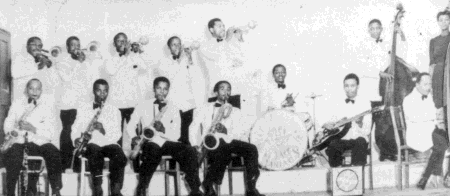 |
In South Africa, the jitterbug dance associated with American swing music became indigenised into the tsaba-tsaba, popular with young urban Flytaal (African-Afrikaans slang) speaking members of the ‘tsotsis’ (i.e. zoot-suits) juvenile sub-culture. The Caribbean biguine was introduced to Congo Brazzaville by black Martinique soldiers of De Gaulle's Free French army and in Sierre Leone calypso bands were formed during the Second World War period by Ali Ganda and Famous Scrubbs.
African troops also fought abroad in the Far East and in North Africa, such as the sixteen thousand ‘Boma’ (i.e. Burma boys) of Nigeria and the East African Kings Rifles. Some of the Education Corps members of the East African Rifles learnt vamping guitar and the rumba abroad, and formed Kenya's famous Rumba Boys on their return. Seven Ghanaian concert party actor-musicians of the West African Frontier Force set up a West African Theatre in Burma and South Africa's Jubulani concert party entertained troops in North Africa where they met Glen Miller. Local popular music was also used in the war effort. For example Ghanaian konkoma highlife (Sackey, 1989), popular concert party theatre, and Nigerian juju music (Waterman,1990) were used for recruiting and wartime propaganda.
THE POSTWAR EMERGENCE OF NEW POPULAR MUSIC STYLES
The impact of wartime troops, the lifting of the wartime ban on record production, the immediate postwar economic boom, the establishment of multi-national recording studios in black Africa [1] , the introduction of electronic amplification, the emergence of mass-independence parties and a new educated generation: all helped shape the numerous popular music genres that mushroomed after the war.
During the late 1940’s in Central Africa local ngoma performance, the Afro-Cuban rumba and American jazz (especially its horn section) were fused into what became known as ‘Congo jazz’ (later soukous). It was first sung in Spanish and later Lingala. Moreover, an increasingly longer fast seben dance section was added after the rumba introduction, based on traditional short-form modal progressions. Congo-Kinshasha pioneers were Antoine Wendo (1949), Kalle's African Jazz (1953) that included the guitarist Dr. Nico and singer Rochereau Tabu Ley (later forming African Fiesta), Franco's O.K Jazz (1956) and Orchestra Les Bantous of Congo-Brazzaville (1959). Congo jazz spread throughout the whole of Africa through records and Congo Brazzaville’s ex-wartime radio transmitter, the most powerful then in black Africa.
|
Luambo Makiadi FRANCO
|
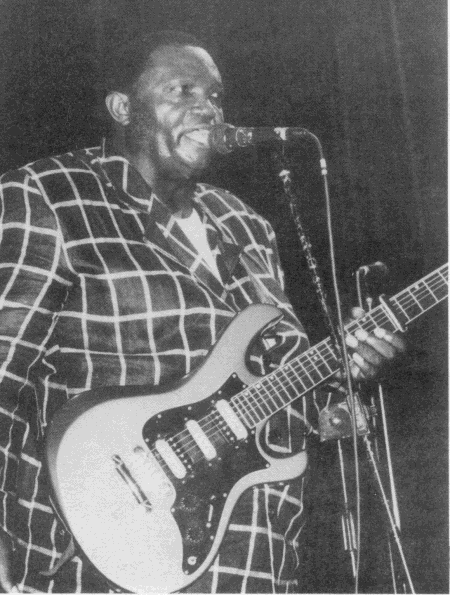 |
In English speaking West Africa maringa, juju music and highlife became the dominant transcultural popular music forms. Sierra Leone's Ebenezer Calendar re1eased almost three hundred maringa songs during the 1950's and in the 60's the Afro-Nationals and other electric maringa bands entered the scene. Due to rising nationalist sentiments and the introduction of amplification, loud traditional hour-glass drums started to be used in Nigerian juju bands (eg. by Ayinde Bakare in 1948) [2] and regional variants of juju evolved. Most important was that played by I. K. Dairo's Morning Star and Blue Spots bands of the 1950's and 60's which enlarged juju trios and quartets to full-scale dance-bands that played at working class nightclubs rather than middle-class salons. Immediately after the war the Yorubas created a comic traveling theatre (partly influenced by local Cantata bible-plays and partly by the Ghanaian concert party) pioneered by Hubert Ogunde who staged several plays against the British colonial authorities.
|
I.
K. Dairo & his Juju Group in the 1950's
|
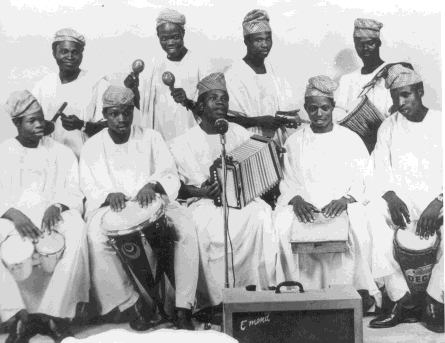 |
Ghanaian highlife went through two immediate postwar developments. Pioneered by E. T. Mensah's Tempos, the huge pre-war dance orchestras were trimmed down to smaller swing-combo size. The resulting ‘dance band highlife’ blended in swing-jazz, calypsos and Afro-Cuban percussion (introduced by the Tempos drummer Guy Warren/Kofi Ghanaba). Many bands were influenced by the Tempos: the Black Beats, Rhythm Aces, Ramblers, Broadway and Uhuru of Ghana, the Ticklers of Sierra Leone, and highlife bands in Nigeria run by Bobby Benson, Victor Olaiya, Bill Friday, Rex Lawson and Victor Uwaifo. The jazz influence on Africa was augmented by trips to Africa by Louis Armstrong in 1956 and again in 1961/2.
|
Tempos in 1952
|
Bobby
Benson &
E. T. Mensah in 1952
|
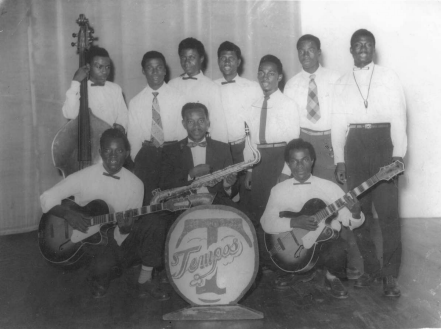 |
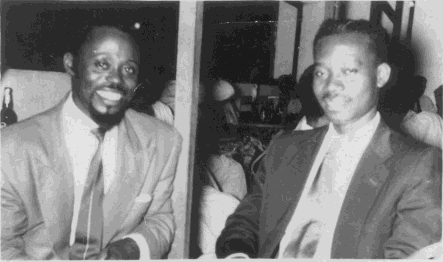 |
The small prewar palmwine highlife groups of Ghana evolved into larger postwar ‘guitarbands’ that borrowed instruments (double-bass, bongos, trap-drums) from the more prestigious highlife dance-bands. In 1952 E. K. Nyame fused the guitar bands with the concert party, creating, in the resulting Akan Trio, a comic highlife-opera format emulated by many others: Kakaikus, Yamoahs, Onyinas, the Jaguar Jokers, African Brothers and Happy Stars of Togo. Most of Ghana's guitar bands, concert parties and highlife dance bands backed Nkrumah's nationalist political party, the CPP.
|
E.
K. Nyame's Guitar Band, 1952
|
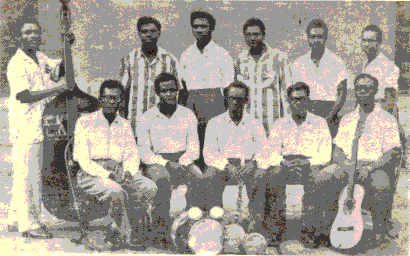 |
In East Africa local beni brass band music died out during the war and was replaced with local variants of the rumba and jazz played, for instance, by the Rhino Boys of Kenya. Their vamping Jimmy Rodger guitar style subsequently spread to the inland Luo and Luhya. This was followed by the ‘dry’ finger picking guitar style of eastern Congo which, in combination with the techniques and high pitched playing of traditional harps and lyres, created the ‘sukuti’ regional guitar style popular in Kenya and Uganda during the 1950's.
For postwar Francophone West Africa Afro-Cuban and Latin American dance music was all the rage in the cities and many elite bands were set up to play this in Spanish or Portuguese. These included La Habanera Jazz of Guinea, the Sor Jazz Band of Senegal, Volta Jazz of Burkina Faso, Alpha Jazz of the Benin Republic, the Melo Togos of Togo, François Lougah’s band in Abidjan and Segou Jazz of Mali. Unlike the two Congos, the full indigenisation of the rumba only took place in Francophone West Africa after the 1960's and will be discussed later.
Immediately after the war in South Africa a proletarian version of black Sophiatown's middle-class swing music appeared, using homemade guitars and cheap penny whistles. This ‘kwela’ music, together with its sexually suggestive ‘phatha-phatha’ dance, became popular with the tsotsi gangs who were becoming increasingly criminalised due to oppressive governmental policies. After the apartheid system was institutionalised in 1948 black urban areas like Sophiatown were destroyed and its inhabitants relocated to townships. A musical result was the growth during the 1950's of ‘mbaqanga’ or ‘township jazz/jive’. This combined elements of jazz, marabi, kwela, Zulu night-music (e.g. of Ladysmith Black Mambazo), itinerant Zulu/Ndebele guitar playing and Sotho ‘focho’ accordion music. Various sub styles of saxophone/guitar/accordion jive arose, the most important being ‘simanje-manje’ (‘now-now’) in which a township jive band backed a female close-harmony group and traditional Zulu ‘male groaner’. The most famous was Miriam Makeba's (ex-Manhattan Brothers) Skylarks, followed by the Dark City Sisters and Mahotella Queens.
|
Miriam
Makeba
|
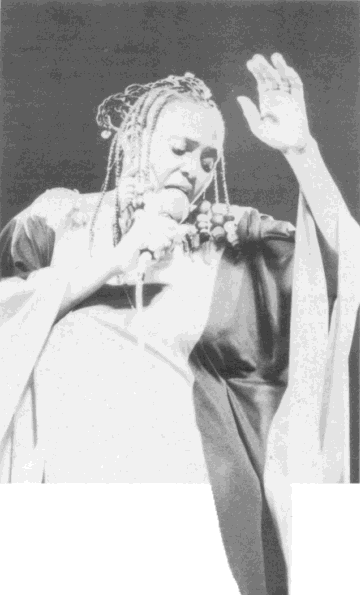 |
THE INDEPENDENCE ERA
With independence (beginning with Ghana, 1957) many African governments actively supported local popular music in line with their concepts of ‘negritude’ (Senghor), ‘African personality’ (Nkrumah) and ‘authenticité’ (Mobutu). State recording, film and television studios were established. Pan-African festivals were held (the first in Dakar, the biggest Nigeria's FESTAC 77), state bands set up, women artists encouraged and music unions instigated.
In Anglophone West Africa the Sierra Leone government made Ebenezer Calender head programmer for state radio and formed the female police dance-band. Similarly Nigeria had its all-female armed-forces band, and Ghana's Nkrumah government formed workers brigade bands and concert parties that included female artists. Unions for dance musicians and local comic opera groups were established in Ghana (1961 and 1960) and Nigeria (1958 and 1971).
After the 1967-70 Nigerian (Biafran) Civil War there was an oil boom that created a strong local record manufacturing industry. During the war, highlife (dominated by easterners) waned in western Nigeria, whilst juju music waxed and turned again into a praise music: supplied to the oil boom ‘nouveau-riche’ by juju music super-star millionaires such as Ebenezer Obey and Sunny Ade. Highlife survived however in the east and midwest of Nigeria played by bands such as the Peacocks, Oriental Brothers, Warriors, Soundmakers, Philosphers National, Rokafil Jazz and Victor Uwaifo's Melody Maestros. In neighbouring Cameroon a local guitar band blend of local palmwine music with Nigerian highlife and Congo Jazz evolved into the makossa.
|
Victor
Uwaifo & King Pagoe Benin City 1974
|
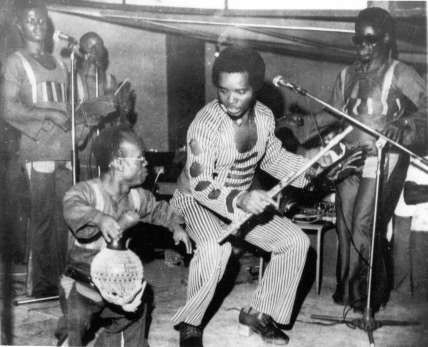 |
Tanzania became independent in 1961 and in 1967 declared Swahili the nationa1 language. There was a ban on foreign pop, but one hundred-and-twenty ‘Swahili jazz’ bands were formed, many (e.g. Vijana and Juwata Jazz) sponsored by Nyerere's socialist government. These all played a local version of Congo jazz introduced by musicians and bands (e.g. Remmy Ongala and Orchestre Makassy) that left Congo-Kinshasha due to its turbulent 1960-5 civil war.
|
Super
Makassy
|
 |
The rise of vernacular transcultural popular dance-music evolved later in Francophone West Africa than in English speaking Africa, partly due to the French ‘direct’ colonial rule in which the colonised either became ‘évolués’ (i.e. black Frenchmen) or remained as ‘indigenes’. This policy, unlike British ‘indirect rule’ through traditional chiefs and institutions, did not foster cross-cultural exchange. However, with independence (beginning with Guinea in 1958) this situation changed rapidly.
In the socialist countries of Sekou Touré’s Guinea and President Keita's Mali, foreign pop music was suppressed and state popular music bands were formed. State radio and record companies were also established to disseminate this music as well as that of the hereditary ‘griot’ (Mandingo ‘jali’) families such as Koyate, Diabate, Suso, Damba and Kante/Konte. During the 1960's state bands like Guinea's Bembeya Jazz and the Les Amazons female police band, and Mali's Super Biton and National Badema (as well as the private Star Band and Baobab Band of Senegal) began the indigenisation of Francophone West African popular music. They combined urban rumbas and Congo jazz with local ingredients from Manding culture and sang in the Manding dialects of Bambara, Malinke, Dioula and Wolof. An example of an ‘Afro-Mandingo’ band is Mali's Rail Band (formed 1970) whose singer Salif Keita and Mory Kanta were griots and whose Guinean guitarist Kante Manfila drew ideas from the twenty-one stringed kora harp-lute of the griots.
|
Francophone Salif Keita
|
 |
Whilst most of Africa moved towards independence after the Second War, southern Africa went through a period of increasing oppression. Civil wars occurred in Zimbabwe (1965-80), Angola (1961-74) and Mozambique (1962-75) that held back the emergence of popular music. In Zimbabwe however, anti Ian Smith [3] ‘chimurenga’ (Shona for ‘liberation’) guitar-band music (influenced by the local mbira hand-piano) was created in the mid-1970's by Thomas Mapfuno and Oliver Mutukudzi. When the Zimbabwean guerrillas returned home from exile in Tanzania they brought home the fast East African versions of Congo jazz with them. This, combined with chimurenga, created the ultra-fast ‘jit’ music of the Bhundu (Bush) Boys and others.
|
Thomas
Mapfuno
|
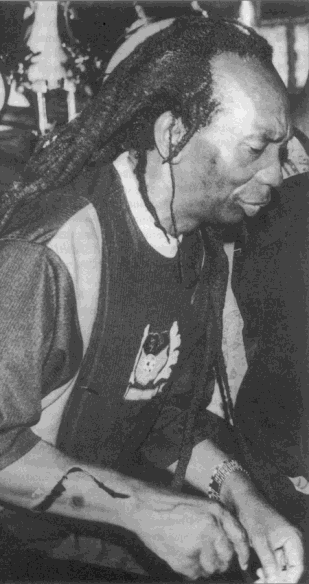 |
After the 1960 Sharpeville massacre of 1960 the political situation went from bad to worse in South Africa. Mbaqanga continued to be played in the townships but, with the destruction of Sophiatown and the banning of integrated bands and audiences (the 1959 King Kong musical was the last multi-racial show under apartheid), many of South Africa's jazz musicians went abroad into exile. These included Ibrahim Abdullah (Dollar Brand), Dudu Pukwana, Chris McGregor's Brotherhood of Breath, Letta Mbulu, Hugh Masekela and Miriam Makeba. Ironically, in the United States, Miriam Makeba switched away from jazz influenced music and became internationally acclaimed for her renditions of South African folk-songs, which (via records and African tours) stimulated many African artists, especially women.
|
Dollar
Brand (Foto Jat Kilby)
|
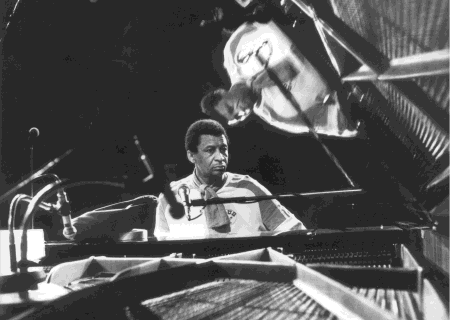 |
‘POP’ MUSIC OF THE 1960's AND THE EXPERIMENTATION OF THE 1970's
From the early 1960's two musical waves swept Africa. One already mentioned was Central African Congo jazz. The other was imported ‘pop’ music, mainly African-American based rock 'n' roll [4] , twist, soul, funk followed by soul inluenced disco and Jamaican reggae. These were introduced through records and sixties tours by James Brown, Chubby Checker, Millicent Small, and Ghana's 1971 Soul to Soul concert that featured Tina Turner, Wilson Pickett and Santana.
|
Rock
'n' roll Dancer in Accra, 1960's (Drum Magazine)
|
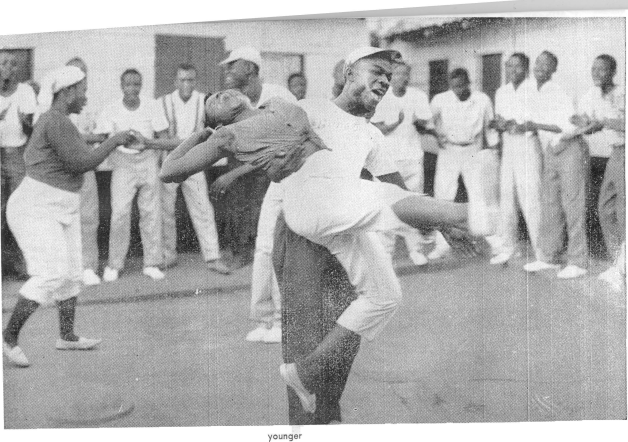 |
At first imitative youthful pop bands sprang up, especially in English-speaking Africa: the Avengers, E1 Pollos and Aliens of Ghana, the Cyclops, Blue Knights and Soul Assembly of Nigeria, the Echoes and Heartbeats of Sierra Leone, the Super Eagles of Gambia, the Chicken Run Band of Zimbabwe and Beaters of South Africa. However, during the 1970's a more experimental ‘Afro-pop’ fusion phase began, due to a combination of various factors. These included the independence Africanisation ethos and Pan Africanism. Also important were the black pride, Afro-centric and back-to-roots message found in African-American soul music and ‘Afro’ fashions, as well as Afro-Caribbean reggae and rastafarianism.
An early pop fusion was the Ewe music of Togo’s Bella Bellow. Another was the ‘Afro-rock’ of Ghana’s London-based Osibisa (composed of ex-highlife musicians). Many other Afro-rock bands followed: Hedzolleh and Boombaya of Ghana, BLO, Mono-Mono, the Funkees and Ofege of Nigeria, the Super Combo of Sierra Leone, Harare and Javuka/Savuka of South Africa: and later Angelique Kidjo of the Benin Republic.
|
Osibisa
|
Johnny
Clegg of Javuka/Savuka
|
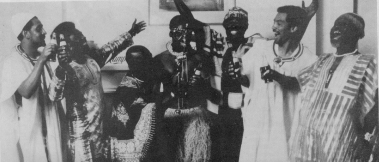 |
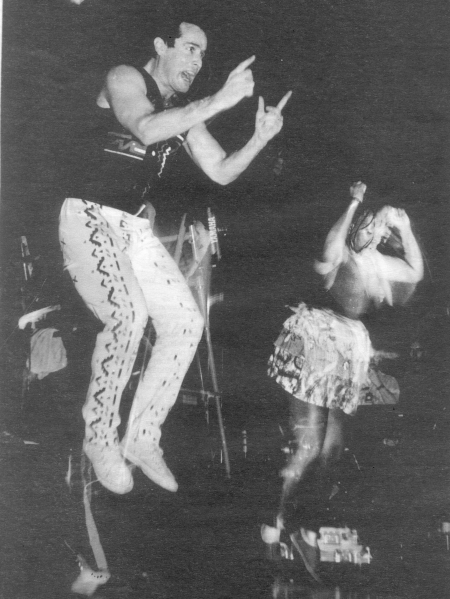 |
|
Afrorock Funkees |
|
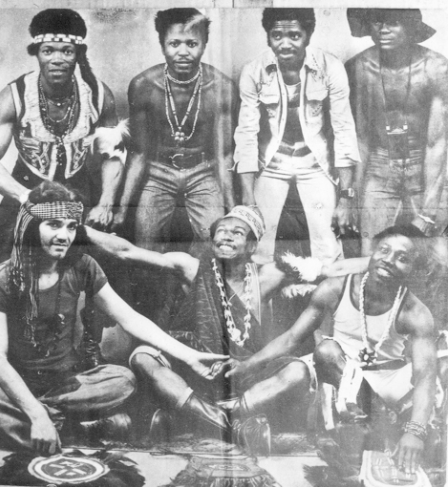 |
Another Afro-pop style was soul influenced ‘Afro-beat’ created in 1969 by Nigeria’s militant and controversial Fela Anikulapo (Ransome)Kuti (an ex-highlife musician), a style taken up by the Polyrhythmic Orchestra of neighbouring Benin, the Big Beats and Sawaaba Sounds of Ghana and Nigerian Afro-beat bands run by Femi Anikulapo-Kuti (Fela’s son), Kola Ogunkoya, Dede Mabiaku and Lagbaja. Other Afro-soul fusions were created by Nigeria’s Segun Bucknor, the South African Soul Brothers (a blend of mbaqana and soul) and the disco-maringa hits of Sierra Leone producer Akie Deen (by Sabanah 75, Bunny Mack and Liberia’s Miatta Fahubulleh). Cameroon's Manu Dibango (ex Kalle’s African Jazz) had an international hit in 1972 with his ‘Soul Makossa’ record and in the early 1980’s German-based Ghanaian musicians created a disco-highlife [5] blend known as ‘Burgher’ (i.e. Hamburg [6] ) highlife.
|
Fela & Africa 70, circa 1970(Foto Juliet
Highet)
|
Manu
Dibango
|
 |
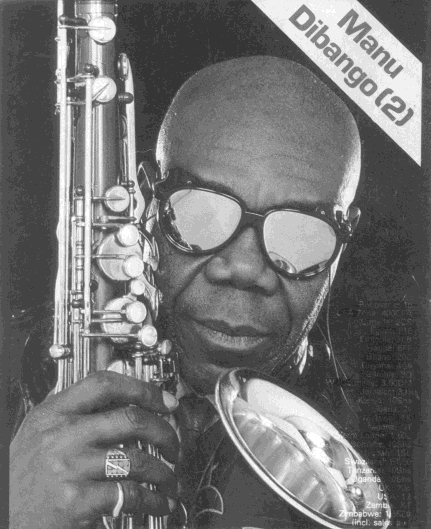 |
Soul also influenced the ‘kiri kiri’ 1969 sub-style of Congo jazz (Kazadi, 1973), the same year that the ‘Zaiko’ Langa Langa (i.e. Zaire plus Kongo) band was formed in Kinshasha. This student oriented group was instrumentally modeled on western Beatles-type pop groups and so did away with the horn section of Congo jazz. Influenced by Mobutu’s current ‘authenticité’ policy, this and other similar groups ( Clan Langa Langa, Zaiko Wa Wa, etc.) used revamped folk-dances (e.g. Cavacha and Zekete Zekete) for the seben section of their songs and did away with the rumba introduction altogether. Ironically ex-Zaiko member, Papa Wemba later became the idol of the young 1980's and 90's ‘sapeurs’ who wore French designer clothes as a snub to the authenticité policy of the increasingly unpopular Mobutu.
|
Papa
Wemba
|
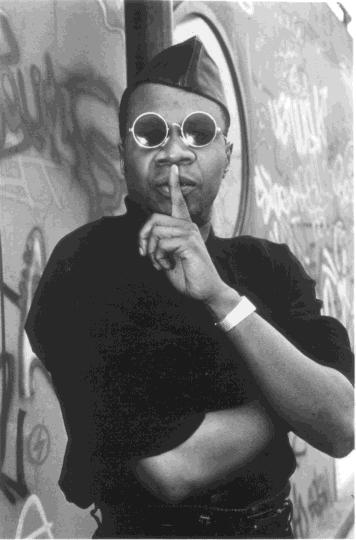 |
Reggae music became fashionable in Africa in the early seventies and many Jamaican artists visited the continent; for instance Jimmy Cliff’s Nigerian tour in 1994 and Bob Marley trip to Zimbabwe's during its independence celebration in 1980. At first in Africa it was all a matter of local bands doing cover versions of the Wailers, etc, but vernacular and other ‘Afro-reggaes’ were soon began to be composed by the Pied Pipers of Zimbabwe, Ghana’s City Boys, K. K. Kabobo, Kwadwo Antwi and Rocky Dawuni, Miatta Fahubulleh of Liberia, Sonny Okosun, Ras Kimono, Majek Fashek and Evi Edna Ogholi of Nigeria, Alpha Blondy of the Cote d'Ivoire and South Africa's Lucky Dube.
|
Alpha
Blondy (Shanachie Records)
|
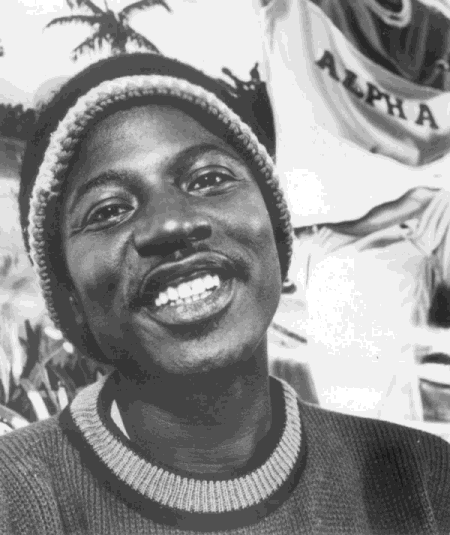 |
Yet another form of popular music experimentation that began from the 1960’s, was the creation of acoustic popular ensembles, or electric ones that drew heavily on traditional instrumental techniques and folk rhythms. Examples of the former are of two types. Firstly the music of neo-folk guitarists such as Koo Nimo of Ghana, Francis Bebey of the Cameroons, Pierre Akendengue of Gabon, S. G. Rogie of Sierra Leone and the blues-griot fusion of Mali’s Ali Farka Toure. Secondly, there are the popular music ensembles that have done away with all or most western instruments. These include the fuji music of western Nigeria, the 1960's maringa influenced acoustic ‘milo jazz’ of Sierra Leone’s Dr. Olu, the ‘Ga cultural groups’ of Ghana pioneered in 1973 by Wulomei and the 1990's neo-traditional ‘sundama’ music of Congo Kinshasa.
|
Koo
Nimo
|
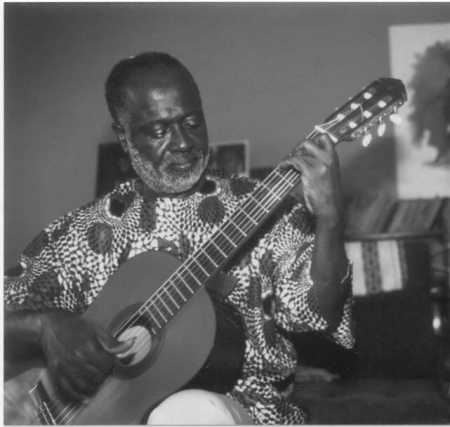 |
Examples of electro-folk fusion popular from the 1970's are the ‘benga beat’ of Kenya and Uganda that, like its sukuti predecessor, draws on the local lyre tradition, the mbira influenced chimurenga music of Zimbabwe, the fast polyrhythmic ‘bikutsi pop’ of the Cameroons that is based on traditional xylophone playing, the previously mentioned Zaiko style of Kinshasa and the Bete folkrhythm influenced music of the Cote d’Ivoire’s Ernesto Dje Dje (his ‘zigblithi’) and Amedee Pierre.
|
Benga
Beat
|
 |
Particularly striking is the string of e1ectro-folk fusions that have been produced in the Manding and Fulani areas of Francophone West Africa since the 1970's. There are the Afro-Mandingo style referred to earlier played by Salif Keita's Ambassadeurs of Mali, Ifang Bondi (ex-Super Eagles) of Gambia, Super Mama Djoubi of Guinea-Bissau, Mory Kante of Guinea and Youssou N'Dour and Toure Kunda of Senegal (‘mbalax’ music). The there are ‘electro-griot’ bands that combine the instruments of the griots with western ones, such as those of Guinea's Sona Diabete (ex-Les Amazons), Gambia's Foday Musa Suso (Mandingo Griot Society), Mali's Tata Bambo, Ami Koita and Toumani Diabate and Senegal's Baaba Maal. A non Mandingo variety of electro-folk is the Malian ‘wassoulou’ sound based on Fula and Peul hunters music, but ironically popularised largely by women artists like Sali Sidibe and Nahawa Doumbia.
|
Youssou
N'Dour
|
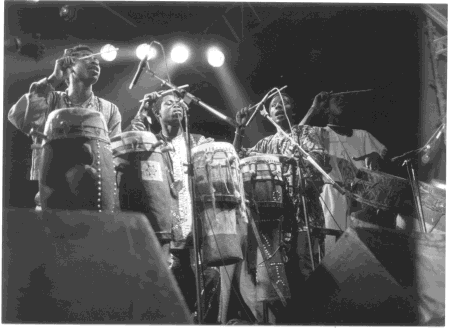 |
POPULAR MUSIC SINCE THE 1980's
In the 1980's and through the 90's three new musical developments emerged in Africa; namely local gospel, local hi-tech computer music and ‘World Music’
Many of the thousands of separatist Christian churches found in Africa allow (unlike western ones) dance for worship, and have since the late 1970’s utilised local popular dance-music bands and records as part of their outreach programs. Examples of such bands are Nigeria’s Charismatic Singers, Imole Ayo's Christian Singers and Sonny Okosun's (ex Melody Maestros) group, the Puritans of Zimbabwe and the ‘gospel-highlife’ bands of Ghana. Local gospel is paving the way for many women artists to enter the local dance-music profession.
|
Aladura Separatist African Church Dancers, Nigeria.
|
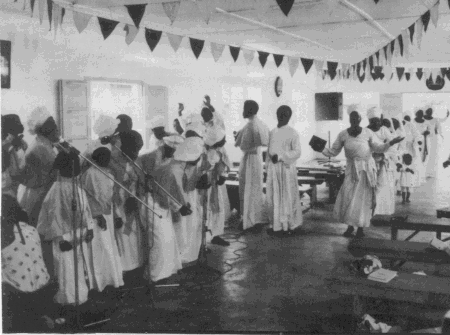 |
Disco-music, rap, house-music and ragga using drum-machines, synthesizer and computers have became fashionable with Africa's youth since the 1980's, and many artists have created local versions of this techno-pop: Nigeria's Bolarin Dawadu, South Africa's Sello ‘Chico’ Twale and Stimela, Guinea's Mory Kante, the Cote d’Ivoire’s Magic System, Cameroon’s Mone Bile, Congo-Kinshasha's Sousy Kassey and Ghana's ‘burgher highlife’ stars George Darko and Daddy Lumba. The latest techo-pop fashion is vernacular rap such as South African kwaito, Ghanaian hip-life, Zimbabwean Zim-rap and the threee thousand local rap groups of Senegal
|
George Darko & Cantata in mid 1980's
|
 |
In the early 1980’s danceable African popu1ar music (coined ‘World Music’ in 1987) became, for the first time, internationally commercially successful and western super-stars like Peter Gabriel, Stuart Coplan, Bob Geldof, Quincy Jones, David Byrne and Ry Cooder began experimenting in this idiom. Most successful was Paul Simon’s 1986 South African inspired ‘Gracelands’ album.
There are various causes for this international explosion of African based world music. One is the large number of African musicians who have moved abroad, beginning with the exodus of South African jazz musicians in the 1960's and followed in the 1970's and 80's by African artists who settled and/or worked in London, Hamburg, Paris, New York and Toronto. Indeed, Paris became the recording Mecca for Francophone Africa from the mid-1980•s (after moving from Abidjan).
A second reason is that with the death of Jamaican reggae star Bob Marley in 1981 international independent (cf. big multi-national ones) recording companies began to look for a new black pop style and super-star, but from Africa instead of the black Americas. Island records (Marley’s label), for instance, in 1982 endorsed Nigerian juju star Sunny Ade. Island Record’s success was followed by other European and later American independent record companies who released albums of Zimbabwean jit bands, Congolese soukous artists (Franco, Mpongo Love, Kanda Bongo Man) and the South African Zulu night-music of Ladysmith Black Mambazo. Currently the focus is on the Afro-beat of the late Fela Anikulapo-Kuti and the music of Francophone West African artists such as Youssou N’Dour, Salif Keita and Ali Farka Toure.
The third reason for the global recognition of African popular music at the close of the 20th century is that it is a logical continuation of a process that began during the 19th century, when the popular music of the black diaspora (spirituals, minstrel songs and ragtimes) crossed over to whites. This continued throughout the 20th century, as a succession of African-American dance-music crazes such as jazz, Afro-Cuban rumba, samba, the blues, rhythm ‘n’ blues, calypsos, reggae, soul hiphop, raga and rap. These have provided the western world with the nearest thing to a contemporary global ‘folk’ dance-music. What we are seeing today with World Music is this process completed. The international recognition of black popular dance-music stemming directly from the African continent itself.
[1] (Decca in 1947 in Ghana was first)
[2] The earlier unamplified juju bands only used a single samba or asiko frame drum so that the stringed instrument( banjo, guitar) would not be eclipsed. However, with the introduction of the amplified guitar and banjo the ‘aural balance’ (Chris Waterman, 1990)) could be altered so as to increase additional drums
[3] He was the leader of Southern Rhodesia that refused to allow black majority rule and made a unilateral declaration of independence (UDI) from Britain in 1965.
[4] A white version of African-American electric rhythm ‘n’ blues that had evolved in cities like Chicago in the 1940’s
[5] Disco was a fusion of soul-funk and drum-machine music developed by groups like Kraftwork in the 1970’s
[6] Created by Ghanaian musicians who had settled in Hamburg due to the economic collapse of Ghana and its music industry in the late 1970’s
Unless otherwise stated all photographs from the John Collins/BAPMAF Popular Music Archives BOX 391, Achimota, Accra,GHANA
___________________________
BIBLIOGRAPHY
ADEMOWU P. W. 1993. History of Fuji Music in Nigeria, Effective Publications, Ibadan.
AGOVI K. E. 1989. The Political Relevance of Ghanaian Highlife Songs Since 1957. Research in African Literatures, Vol. 20 (3).
AIG-IMOUKHUEDE F. 1975. Contemporary Culture in Lagos. In The Development of an African City, (ed) A.B. Aderibigbe, Longman, Nigeria.
ALAJA•BROWNE A. 1985. Juju Music: A 5tudy of its Social History and Style. Ph.D Dissertation, University of Pittsburgh, USA.
ANDERSON A. M. 1991. Music in the Mix: The Story of South African Popular Music, Ravan Press, Johannesburg, South Africa.
BALLANTINE C. 1993. Marabi Nights. Ravan Press, Johannesburg, South Africa.
BAME K. N. 1985. Come to Laugh: African Traditional Theatre in Ghana. Lillian Barber Press, New York.
BARBER K. 1987. Popular Art in Africa. In African Studies Review, vol.10 (3), September, pp. 1-78.
BARLOW J. S. and EYRE B. 1995. Afropop. Chartwell Books, USA.
BENDER W. 1986. Sweet Mother: Africanische Musik. Trickster Verlag, Munich.
--------1989. Ebenezer Calender and Appraisal. In Bayreuth African Studies Series 9, (ed) E. Breitinger, Bayreuth University, pp. 43-69.
BILBY K. M. 1985, The Caribbean as a Musical Region. The Woodrow Wilson International Centre for Scholars, Washington D.C.
BREMPONG 0. 1984. Akan Highlife in Ghana: Songs Or Cultural Transition. PhD Thesis, Indiana University, USA.
BROOKS Jr. G. E. 1972. The Kru Mariner in the 19th Century. Liberia Monograph Series No 1. Dept. of Anthropology, University of Delaware.
CATHCART J. 1989. Hey You: Portrait of Youssou N'Dour. Fine Line Books, London.
CHERNOFF J. 1979. African Rhythms and African Sensibility. University of Chicago Press.
CLARK Ebun 1979. Hubert Ogunde: The Making if Nigerian Theatre. Oxford University Press.
COLLINS E. John 1976. Comic Opera in Ghana. In African Arts, UCLA, vol. 9 (2), January, pp. 50-57. Republished in Ghanaian Literatures (ed) K. Priebe, Greenwood Press, Connecticut,1988, pp. 61-72.
--------- 1976. Ghanaian Highlife. In African Arts, UCLA, vol.19 (1), October, pp. 62-8 and 100.
-------- 1977. Postwar Popular Band Music in West Africa. In African Arts, UCLA, vol 10 (3), April, pp. 53-60. Republished in German in Populare Musik in Afrika, (ed) V. Erlmann, Museum Fur Volkerkunde, Berlin, 1991.
-------- 1979. Crisis in the Ghanaian Music Industry. West Africa Journal. London, August 20th. Republished in German in Lesebuch Zur Afrikanischen Kulture, (ed) A. Infield, Unionsverlag, Zurich, 1980.
---------1985. Music Makers of West Africa, Three Continents Press, Washington DC.
----------1985. African Pop Roots. Foulshams, London.
---------1985 The Concert Party in Ghana, Musical Traditions, Exeter, (ed.) Keith Summers, No.4.
---------1987. Jazz Feedback to Africa. In American Music ( ed) J. Graziano, Univ. of Illinois Press, vol. 5 (2), Summer, pp. 176-193.
---------1988. Comic Opera in Ghana. Ghanaian Literatures, (ed.) R. Priebe Greenwood Press, U.S.A.
----------1989. The Early History of West African Highlife Music. Popular Music, (ed.) by J. Farley and S. Rijven, Cambridge University Press, Vol.8, No.3, October.
----------1989. African Music Strengthens Cultural Autonomy, (ed) S. O’Connell, Group Media Journal, vol. VIII, Munich.
----------1989. Article on West African Popular Music (translated into Japanese) for Japanese Noise: Music Magazine, (ed.) Toyo Nakamuru, Tokyo, Number 1, Spring.
----------1990. Running a Band, Music Studio and Music Archives in Ghana. Proceedings of Conference on Regional Audio-visual Archives, Falun, Sweden, Delarna Research Council.
----------1991.The Popular Music of West Africa (translated into German) Populare Musik in Afrika, (ed) Velt Erlmann, Museum fur Volkekunde Germany.
----------1992. The Ghanaian Concert Party - Popular Entertainment and the Ghanaian School Syllabus, (eds) A.Boeren and K. Epskamp, Ceso Paperback No. 17, The Hague, Centre for the Study of Education in Developing countries.
-------- 1992. West African Pop Roots, Temple University Press, USA.
-------1992. Some Anti-Hegemonic Aspects of African Popular Music. In Rockin’ The Beat: Mass Music and Mass Movements, (ed) R. Garafolo, Southend Press, Boston.
----------1994. The Problem of Oral Copyright: The. Case of Ghana. Chapter 8 of Music And Copyright, (ed) Simon Frith, Edinburgh University Press.
---------1994. The Ghanaian Concert Party: African Popular Entertainment at the Crossroads. PhD Dissertation, SUNY Buffalo. Available from Customer Service for Dissertations, University Microfilms Inc. 300 North Zeeb Road, Ann Arbor, Michigan 48106-1346.Publication Number 95-09102.
---------1994 Highlife Time. Anansesem Press, Accra.(second revised version -1996.
---------1996 Music Feedback: African America's Music in Africa, (ed) Lisa Brock, Issue: A Journal of Opinion, African Studies, vol. XXIV/2.
---------1996. E. T. Mensah, the King of Highlife. Anansesem Press, Accra.
---------1997. Fela and the Black President Film. In Glendora African Quarterly of the Arts, (ed) Dapo Adeniyi, Lagos, Vol. 2, No. 2, pp.57-73.
--------1998. The Ghanaian Concert Party. In Glendora Review: in African Quarterly of the Arts (ed D. Adiniyi), Lagos, vol. 1 (4, pp. 85-88.
--------1999. The Evolution of West African Popular Entertainment. The Encyclopedia of Sub-Saharan Africa (ed) John Middleton, Charles Scribner and Sons Reference Books, U.S.A.
--------1999. Ghana Entry (with Ronnie Graham) for the Rough Guide to World Music,Volume 1, (eds. S. Broughton, M. Ellingham and R. Trillo). Published by Rough Guide/Penguin, London, pp.488-498.
--------2000. Hitechnology, Individual Copyright and Ghanaian Music, in the book Ghana: Changing Values/Changing Technologies, (ed) Helen Lauer, published by the Council for Research in Values and Philosophy, U.S.A.
------- 2000 Paper on the African Music Industry. For the June 20th 2000 Workshop of the World Bank on Developing the Music Industry in Africa.. Available from the Policy Science Center, 127 Wall St. Room 314, BOX 208215, New Haven,CT.06529-8215. (www.worldbank.org/research/trade/africa_music2.htm.
-------2000 La Musique Poulaire de L’Ouest Africain Anglophone, in Notre Librarie: Literatures du Nigeria et du Ghana:2 (ed.) Jean-Louis Joubert. Published by the French Ministry of Foreign Affairs, Number 141, July-September, pp. 114-118.
------- Forthcoming Fela: Nigeria’s Afrobeat Warrior Forthcoming from Off The Record Press of London.
COLLINS E. JOHN and RICHARDS P. 1989. Popular Music in West Africa (an Interpretive Framework). In World Music, Politics and Social Change (ed) S. Frith, Manchester University Press, pp. 12-46.
COLLINS E. JOHN (with BARBER K. and RICARD A.) 1997. West African Popular Theatre. Indiana Univ. Press/James Currey.
COPLAN D. 197S. Go to my Town Cape Coast: The Social History of Ghanaian Highlife. In Eight Urban Musical Cultures, (ed) B. Nettl, University of Indiana Press.
--------- 1985. In Township Tonight: South Africa•s Black City Music and Theatre. Ravan Press, Johannesburg, South Africa.
CORNET J. 1958, La Bataille de Rail. Brussels.
DARKWA A. 1974. New Musical Traditions from Ghana. PhD Dissertation, Wesleyan University, USA.
DIBANGO M. and ROUARD D. 1990. Trois Kilos de Cafe. Lieu Commun, Paris.
DIKOBE M. 1973. The Marabi Dance, Heinemann, London.
DUBE C. 1997. Art from the Frontline: Contemporary Art from Southern Africa. Karia Press, London.
DONNER P. 1980. Music Forms in Tanzania and their Socio•economic Base. In Transactions of the Finnish Anthropological Society, Jipemoyo Magazine, Helsinki, no 9, pp. 8-9.
DURAN L. 1986. Djely Mousso, Folk Roots, vol. 11 (3), September, pp. 34-9.
ECHERUO M. J. C. 1962. Concert and Theatre in Late 19th Century Lagos. Nigeria magazine, Lagos, no.74, September, pp. 68-74
ERLMANN V. 1988. A Feeling of Prejudice: Orpheus McAdoo and the Virginia Jubilee Singers in S. Africa 1890•9. In Journal of Southern African Studies, vol. 14 (3), April, pp. 332-350.
EWENS G. 1991. Africa Oh Ye: A Celebration of African Music, Guinness, London.
-------- 1994. Congo Colossos: Franco and OK Jazz, Buku Press, UK.
FABIAN J. 1978. Popular Culture in Africa: Findings and Conjectures. In Africa, vol 48 (4), pp. 315-334.
FOSU-MENSAH 1987. On Music in Contemporary West Africa. In African Affairs, London, vol. 86 (343), April, pp. 227-240.
GRAHAM R. 1988-98. Stern’s Guide to Contemporary African Music, Vol I and 2, Zwan and Off The Record Press, London/ Pluto Press, London.
HARREV F. 1987. Goumbe and the Development of Krio Popular Music In Freetown Sierre Leone. Paper read at 4th International Conference of the International Association for the Study of Popular Music, Accra.
--------1989. Jambo Records and the Promotion of Popular Music in East Africa. In ,Bayreuth African Studies Series, (ed) W. Bender, Bayreuth University, Germany, no 9, pp. 103-137.
HAYDON G. and MARKS D. (eds) 1985. Repercussions: A Celebration of African-American Music, Century Publishing, London.
HORTON C. Dowu 1984. Popular Bands of Sierre Leone 1920 to present. In Black Perspectives in Music, Cambria Heights, New York, vol. 12 (2), pp. 183-92.
JACOBS J. U. 1989. The Blues: An Afro-American Matrix for Black South African Writing. In English in Africa, vol. 16 (2), 0ctober, pp. 3-17.
JEGEDE D. 1987. Popular Culture and Popular Music: The Nigerian Experience. In Presence Africaine, no 144, pp. 59-72.
JEYIFO B. 1984. The Yoruba Popular Traveling Theatre of Nigeria. Nigerian Magazine, Lagos.
JOHNSON Rotomi 1989. The Language and Content of Nigerian Popular Music. In Bayreuth African Studies Series (ed), W. Bender, Bayreuth University, Germany, pp. 91-102.
KAUFFMAN R. 1975. Shona Music: A Process which Maintains Traditional Value. In Urban Man in Southern Africa (eds) C. Kileff and W. C. Pendelton, Mambo Press, Zimbabwe.
KAVYU R. N. 1978. The Development of Guitar Music in Kenya. In Jazz Research, Germany, no. 10, pp. 111-119.
KAZADI 0. 1973. Trends in 19th and 20th Century Music in Zaire-Congo. In Musikulturen Asiens, Afrikas und Oceaniens, (ed) von Robert Gunther, Gustav Bosse Verlag, Regensburg, no. 9, pp. 267-288.
KERR D. 1995. African Popular Theatre. James Currey, London.
KING B. 1966. Introducing the Highlife, Jazz Monthly, July, pp. 3-8.
KONATE Y. 1987. Alpha Blondy: Reggae et Société en Afrique Noire, Karthala Press, Paris.
KUBIK G. 1974. The Kachamba Brothers Band: A Study of Neo-Traditional Music in Malawi. Zambian Papers, no.9.
-------1981 Neo-Traditional Popular Music in East Africa Since 1943. In Popular Music, (eds) R. Middleton and D. Morn, Cambridge Univ. Press.
LEE H. 1988. Rockers d’Afrique: Stars et Légendes du Rock Mandingue. Albin Michel, Paris.
LEONARD L. 1967. The Growth of Entertainment of Non Africa Origin in Lagos from 1866-1920. Ph.D Thesis, University of Ibadan, Nigeria.
LlPSITZ G. 1994. Dangerous Crossroads. Verso, London/New York.
LOW J. 1982. A History of Kenyan Guitar Music 1945-80. African Music, Grahamstown, vol. 6 (2), pp. 17-36.
---------1982 Shaba Diary (Katanga Guitar Styles) Acta Ethnologica et Linguistica, Series Africana 16, Vienna.
MAKEBA M. and HALL J. 1987. Makeba - My Story. New African Library, New York.
MALAMUSI M. A. 1984. The Zambian Popular Music Scene. Jazz Research, vol.16, Graz.
MAKWENDA C. J. 1990. Zimbabwean Contemporary Music of the 1940•s•60•s. Paper at Audio-Visual Archives Conference, Fayum, Sweden, July.
MANUEL P. 1988. Popular Music of the Non Western World. Oxford Univ. Press.
MARRE J. and CHARLTON H. 1983. Beats of the Heart: Popular Music of the World, Pluto Press, London.
MARTIN S. H. 1982. Music in East Africa: Five Genres in Dar Es Salaam. In Journal of African Studies, vol 9 (3), Fall, pp, 155163.
MATONDE K. 1972. La Musique Zairoise Moderne, Kinshasha.
MENSAH A. A. 1971/72 Jazz the Round Trip. In Jazz Research, no.3/4, Graz.
MITCHELL J. C. 1956. The Kalela Dance. Rhodes-Livingstone Papers, no. 27.
MOORE C. 1982. Fela Fela This Bitch of a Life. Allison and Busby, London.
NKETIA J. H. K. 1956. The Gramophone and Contemporary African Music in the Gold Coast. Institute of Social and Economic Research, University of Ibadan.
NUNLEY J. W. 1987. Moving with the Face of the Devil: Art and Politics in Urban West Africa. University of Illinois Press, Urbana and Chicago.
OBATA J. K. 1971. Soul Music in Africa. The Black Scholar, California, vol. 2 (6).
OMIBIYI-OBIDIKE M. A. 1987, Women in Popular Music in Nigeria. Paper at 4th International Conference of International Association for the Study of Popular Music, Accra, Ghana.
PONGWENI A. J. C. Songs that Won the Liberation War, College Press, Zimbabwe.
RANGER T. O. 1975. Dance and Society in Eastern Africa 1890-1970. Heinemanns, London.
RICARD A. 1977. The Concert Party as a Genre: The Happy Stars of Lome. In Forms of Folklore in Africa, (ed) B. Lindfors, Austin, Texas.
ROBERTS J. S. 1974. Black Music of Two Worlds. William and Morrow, New York.
RYCROFT D. 1961/1961. The Guitar Improvisations of Mwenda Jean Bosco, Part One/Two. African Music, vol. 2/3 (1/4), pp. 81-98/86-102.
---------1977. Evidence of Stylistic Continuity in Zulu ‘Town’ Music. In Essay for a Humanist (Klaus Waschmann), Town House Press, New York, pp. 216-260.
SACKEY C. K. 1989. Konkoma: A Musical Form of Fanti Young Fishermen in the 1940’s and 50's in Ghana W. Africa, Dietrich Reimer Verlag, Berlin.
SCHMIDT C. (ed) 1994. The Guitar in Africa 1950’s-90’s. The World of Music, IITM, Germany, vol. 36 (2).
SEAGO A. 1985. East African Pop Music. Heinemann, London.
SMITH M. E. 1962. Popular Music of West Africa. African Music, vol. 2 (1).
SPRIGGE R. 1961. The Ghanaian Highlife: Notation and Sources. In Music in Ghana, Institute of African Studies, Univ. of Ghana, Legon, pp, 7-94.
STAPLETON C. and MAY C. 1987. African All Stars, Quartet Books, London.
STEARNS M. and J. 1968. Jazz Dance: The Story of American Vernacular Dance McMillan, London.
SUTHERLAND Efua. 1970. The Original Bob: The Story of Bob Johnson Ghana’s Ace Comedian. Anowuo Educational Publications, Accra, Ghana.
VAN DER GEEST S. and ASANTE-DARKO N. K. 1982. The Political Meaning of Highlife Songs in Ghana. In American Studies Review, vol. XXV (1), March, pp. 27-35.
WALLIS R. and MALM K. 1984. Big Sounds from Small People, Constable, London.
WARE N. 1978. Popular Music and African Identity in Freetown, Sierre Leone. In Eight Urban Cultures: Tradition and Change, (ed) Bruno Nettl, University of Illinois Press, pp. 196-319.
WATERMAN C. 1990. Juju: A Social History and Ethnography of an African Popular Music. University of Chicago Press, Chicago.
YANKAH K. 1984. The Akan Highlife Song: A Medium for Cultural Reflection or Deflection? In Research in African Literatures, vol 15 (4), Winter, University of Texas Press, pp. 568-582.
ZINDI F. 1980. Roots Rocking in Zimbabwe, Mambo Press, Harare, Zimbabwe.
|
_________________________________________________
|